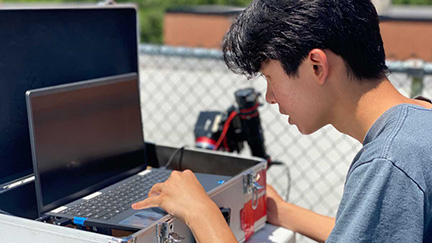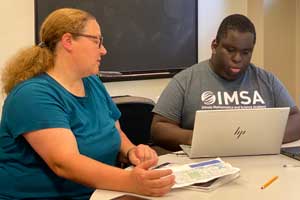by Tim Crosby
CARBONDALE, Ill. – Scientists are predicting the possibility of solar storms of varying intensity during the next two weeks as faculty and student researchers at Southern Illinois University Carbondale continue studying the sun with two NASA-funded research projects.

Kennedy Su, a student at the Illinois Mathematics and Science Academy, makes one of his daily solar observations while attending a summer research experience at Southern Illinois University Carbondale. IMSA student Alain Bedi works with Cori Brevik, associate professor in the School of Physics and Applied Physics. (Photos provided)

Faculty are conducting SolarSTEAM, a $2.6 million multifaceted, national heliophysics project building on research and outreach experiences from the 2017 and 2024 total solar eclipses that hit Southern Illinois. The faculty also are running the Dynamic Eclipse Broadcast Initiative (DEB), a two-year, $314,000 project that equipped, coordinated and trained more than 80 teams of citizen science observers across North America – providing critical coronal data as the moon’s shadow traversed the continent.
The work has continued during the weeks following the eclipse, with SIU welcoming students from the Illinois Mathematics and Science Academy attending a summer research experience through the university’s STEM Education Research Center. Two of those students are making daily solar observations, watching the surface of the sun and doing image processing on data collected by the DEB Initiative during the April total solar eclipse.
“Their work is part of an ongoing nationwide effort to observe the surface of the sun and look for connections between surface features on the sun such as sunspots and white light solar flares,” said Bob Baer, associate scientist in the School of Physics and Applied Physics at SIU and one of the researchers. “The work is important in learning more about our sun and solar flares, which can have a significant impact on our life here on Earth.”
Today’s (June 28) solar forecast calls for aurora borealis sighting as far south as mid-Wisconsin as a geomagnetic storm brought on by high-energy particles and magnetism emanating from a sunspot cluster that is rotating to face Earth. The activity is part of solar maximum, an active time during the sun’s cycle.
“Increased solar activity such as what we will continue to see through solar maximum over the next year provides a better opportunity for observations to capture useful data,” Baer said.
Faculty researchers on-hand include:
- Cori Brevik, an associate professor in the School of Physics and Applied Physics, is involved with several solar research projects and is leading a team of researchers from SIU and Adler Planetarium in Chicago on the REAL Field Trip Model. Funded by a two-year, $465,000 grant from the National Science Foundation, the project is aimed at pioneering a way to allow any school, regardless of location, to actively participate in large-scale scientific events. REAL stands for Remote Engagement and Access to Learning.
- Harvey Henson, an associate professor in the School of Education and director of SIU’s STEM Education Research Center, is involved with several solar research projects and is leading a team of researchers on the SolarSTEAM (STEAM standing for science, technology, engineering, arts and mathematics).
